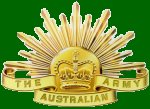The Challenge In the context of the Korean Conflict, the Australian Army was confronted with considerable problems with the necessity of having to train a viable Infantry force at extremely short notice. This was further complicated by having to rely on a limited number of Regulars and hurriedly recruited Volunteers.
The under-manned Third Battalion of the Royal Australian Regiment was still in Japan at that time of its imminent return to Australia. Fortunately, in contrast with most other Combat units serving as part of the Occupation of Japan, the battalion had undergone constant field exercises with field firing and minor tactics.
So by the time Australian troops were introduced to the battlefield in Korea, during Sept 50, they had a rather hotchpotch team of Regulars (often without previous combat experience) as well as Volunteers, who at that early stage, comprised in the main experienced men from WWII.
By this it will be seen that, at that early stage no particular training system had been instituted to meet the challenges awaiting our troops in the Korean conflict. Nevertheless it was good to know that the troops were all confident in using their weapons with telling effect. They also quickly became united into a coherent and highly motivated fighting machine.
The Diggers’ early exposure to combat, (to many experiencing their baptism of hostile fire) gave them an excellent ‘on the job training’ opportunity!
The Call to Arms It was gratifying to find that very soon a large rush to arms was experienced with volunteers offering their services in droves for various motives and from all walks of life.
Accordingly, urgent priority had to be given to effective training of men still awaiting posting to Korea.
Prior to allowing the volunteers to proceed to Korea, they had to undergo strictly concentrated training and administrative preparations
The Training System
This called for normal training of all ranks in weapon handling, field firing, minor tactics, as well as in the general requirements such as First Aid, map reading swimming, rope work etc over confidence courses under simulated fire, carrying of wounded, physical fitness regimes, grenade throwing, field craft, range work and associated activities.
After thorough individual training, the Diggers were exposed to more advanced training as members of a Section comprising 10-12 men and as part of a three section platoon.
The overall preparation of each individual soldier for posting to Korea, was structured in accordance with a ‘Draft Priority’ (DP) system of four distinct stages.
These were organised as follows: -
- DP 4 = Induction and Recruit Training.
- DP 3 = Field training in sound and effective battle drills, map reading and navigation exercises.
- DP 2 = advanced training in the field under the strictest and most realistic combat conditions, battle inoculation, patrol work, and hardening for the rigours of battle with particular emphasis on ‘mateship’ and all its vital implications within the Australian ethos.
- Because of the increased involvement of our troops in patrol work (particularly by night) in Korea, special emphasis was given to the soldiers’ preparation for the various tactics employed in such operations
- DP 1 = finalisation of medical and dental fitness checks, inoculations and preparation of wills.
Meticulously compiled records were kept for every soldier, showing the successful completion of each DP stage, without which they were not considered for posting to Korea.
As the war continued, it was possible to obtain the services of men returning from the conflict in Korea as most effective instructors
Soldiers whilst still in Japan awaiting posting to battalions underwent yet more strenuous battle training, at the British Commonwealth Battle School, prior to being sent to the ‘ sharp end’
Training of Junior Leaders Much emphasis was given to the training of junior leaders who would earn the honour and responsibility of leading the soldiers on the battlefield.
Junior leaders are reminded of their need to lead by example, to inspire confidence and to readily accept responsibility, to give clear orders and to develop trust and confidence.
They are further reminded of the need to keep their soldiers informed, to insist on sound battle procedure and never to show fear or to panic.
Leaders are made aware that the soldiers under their leadership are their judges and will invariably accept, tolerate or reject them.
Furthermore, they are left in no doubt that success in battle will be influenced largely by the standards and conduct of the junior leaders.
Conclusion The system thus adopted proved to be gratifyingly effective on the battlefield.
Our soldiers were adequately prepared for their tasks in all respects, thus ensuring that minimum number of casualties would be sustained and the tasks allotted to our Force were conducted with telling effect.
Major Alec Weaver, Royal Australian Regiment (Ret)
1998



